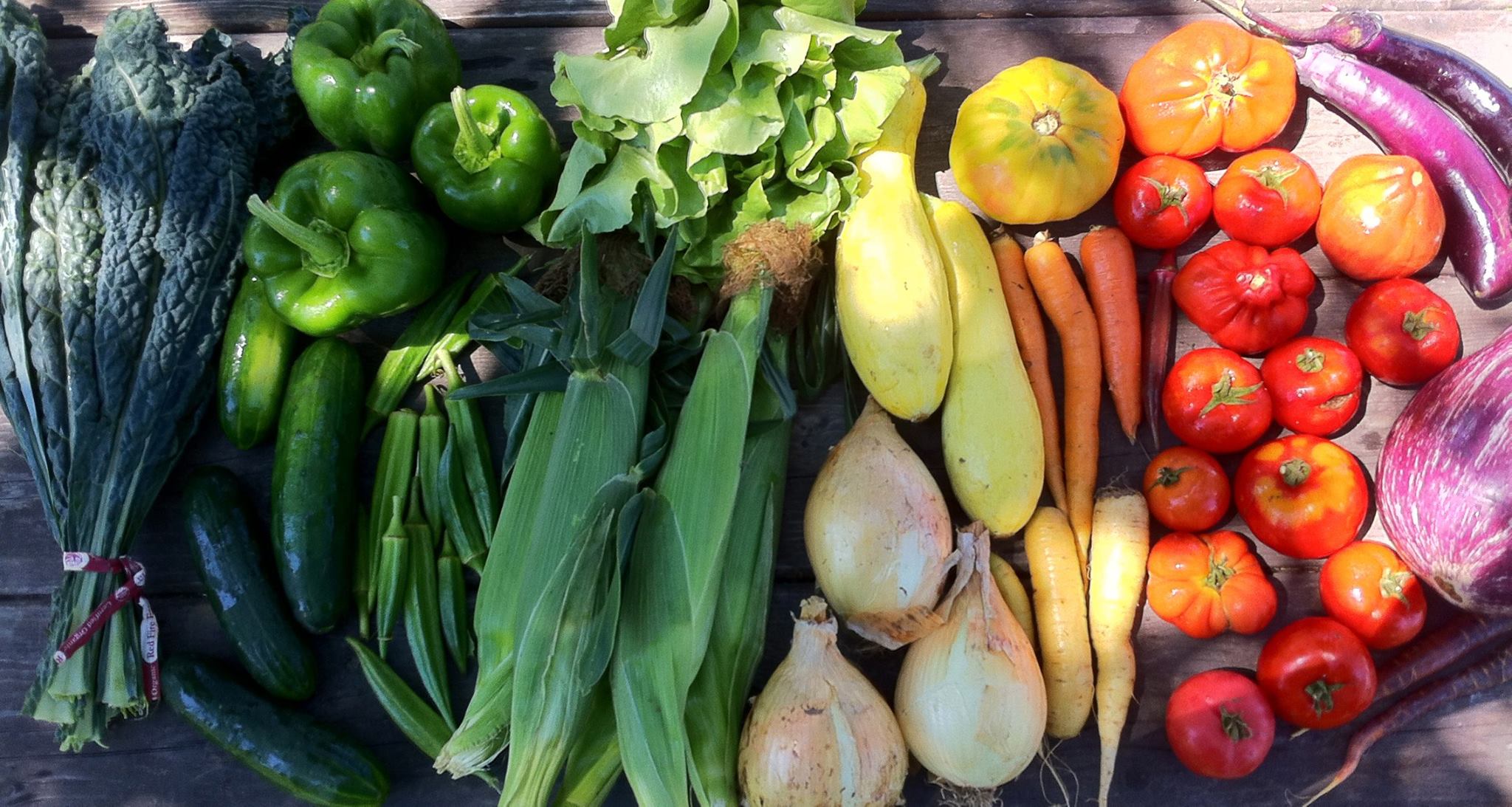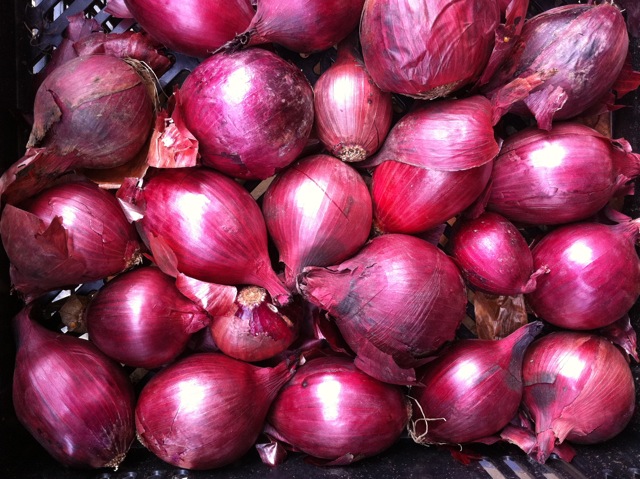Cabbage Harvest Story and Sauerkraut Recipe
Brassica oleracea capitata. Latin for cabbage. From a wild cabbage, through centuries of breeding and selection, came many food crops in the brassica family that we eat today… broccoli, kale, Brussels sprouts, kohlrabi, cauliflower, bok choy. This family is very important on our farm, as many of the crops are hardy to the cold and help us extend the season of local food.

Hamida with two cabbages in the field. These would make a great batch of kraut!
This time of year, hopefully before we get weather in the low teens or below, we are harvesting the cabbage for winter storage. When the big fall cabbages start rolling in, it’s also the time we start to make sauerkraut in earnest at our house. You can make it too. You can find our organic cabbage at our winter farmers’ markets, with Bulk Order for pickup around Massachusetts, and in our CSA farm shares.

First we harvest the cabbage into rows. Then it goes air-born. Zeinab catches cabbage to fill up the pallet bins.
Sauerkraut is German for “sour cabbage.” Though I would describe the flavor as tangy instead – likely from the high vitamin C content. Sauerkraut is lacto-fermented, meaning the food is made with the help of naturally occurring beneficial bacteria that create a lactic acid environment. Eating this live food is good for your health, because of the live cultures, increased nutrient availability, and beneficial compounds. Read more about the health benefits from some of our local kraut makers – Real Pickles. And more on wikipedia.
It’s one of my goals over time to weave the making of sauerkraut and fermented foods into my life year round. The flavors and health aspects are so compelling. I’ve found sauerkraut makes a good place to start, as it is simple, and very worthwhile.
How to Make Sauerkraut
 Chop cabbage to desired size for eating
Chop cabbage to desired size for eating- Salt to taste, and then squeeze or pound to get the water moving out of the cabbage. You can mix in flavorings at this point. See below for ideas!
- Pack cabbage tightly into a clean non-reactive container, pushing it down so that liquid rises above the vegetables. You can add water if needed. We usually weigh down the kraut in our glass jar with another smaller glass jar filled with water that nestles inside the mouth of the main jar, then cover the whole setup with a cloth or napkin to keep dust and bugs out of the opening.
- Let sit out on a counter, and taste often until you like the flavor, then put in the fridge to slow the ferment. Skim off any mold that forms on the surface (it’s okay, just remove it). Make sure the liquid level is above the vegetables when you check it, as you want to keep the process anaerobic. You can add more brine (2 tbs salt per quart water works). If the top layer gets exposed to air and looks bad, remove a layer, often it is perfect and smelling good underneath. Don’t put in direct sun like these photos, as UV rays kill your beneficial bacteria.
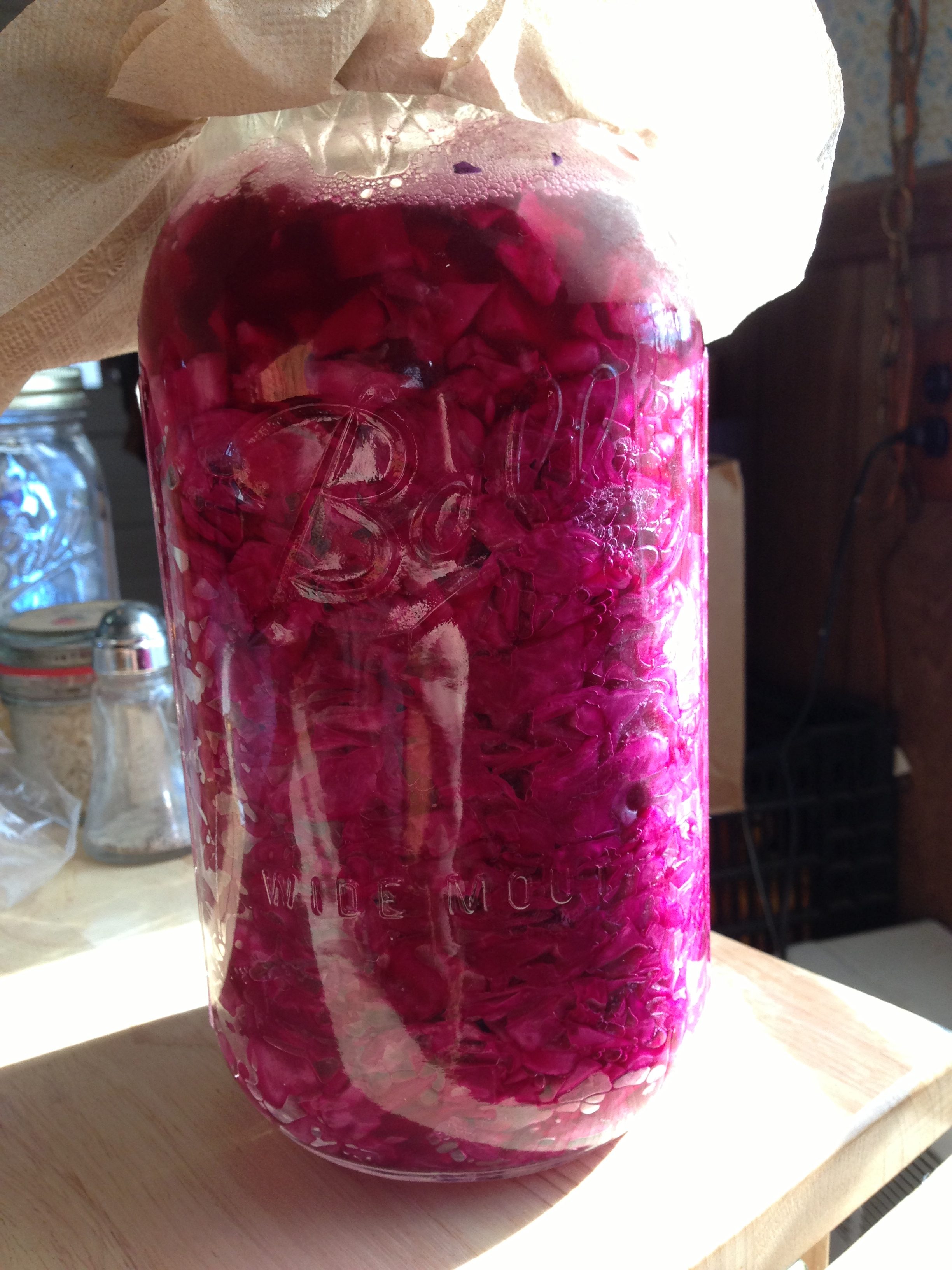
Red cabbage sauerkraut.
I like the freshness and crunch of the cabbage at the 3-5 days stage, but we usually let it go longer to develop more tang and flavor over 2 weeks or so. Taste as you go and eat some when you like it! You can have cabbage ferment at a much slower pace in a cooler environment – this is how lacto-fermentation was used as long term storage for many foods to help people get through the winter. That is essentially what you are doing when you put it into the fridge as well, slowing down the ferment. But it keeps going and stays alive, and will hold a very long time in your refrigerator.
Salting
For the amount of salt, Ryan just wings it. Fermentation master Sandor Katz says, “In most ferments, including vegetables, salting can be done to taste, without any need for measuring.” He also says that commercial sauerkraut makers use 1.5-2 tsp salt for each pound of chopped cabbage. You can ferment without salt, though salt helps keep vegetables crunchy, brings water out, and makes a more secure environment for lactic acid bacteria (ones you want!).
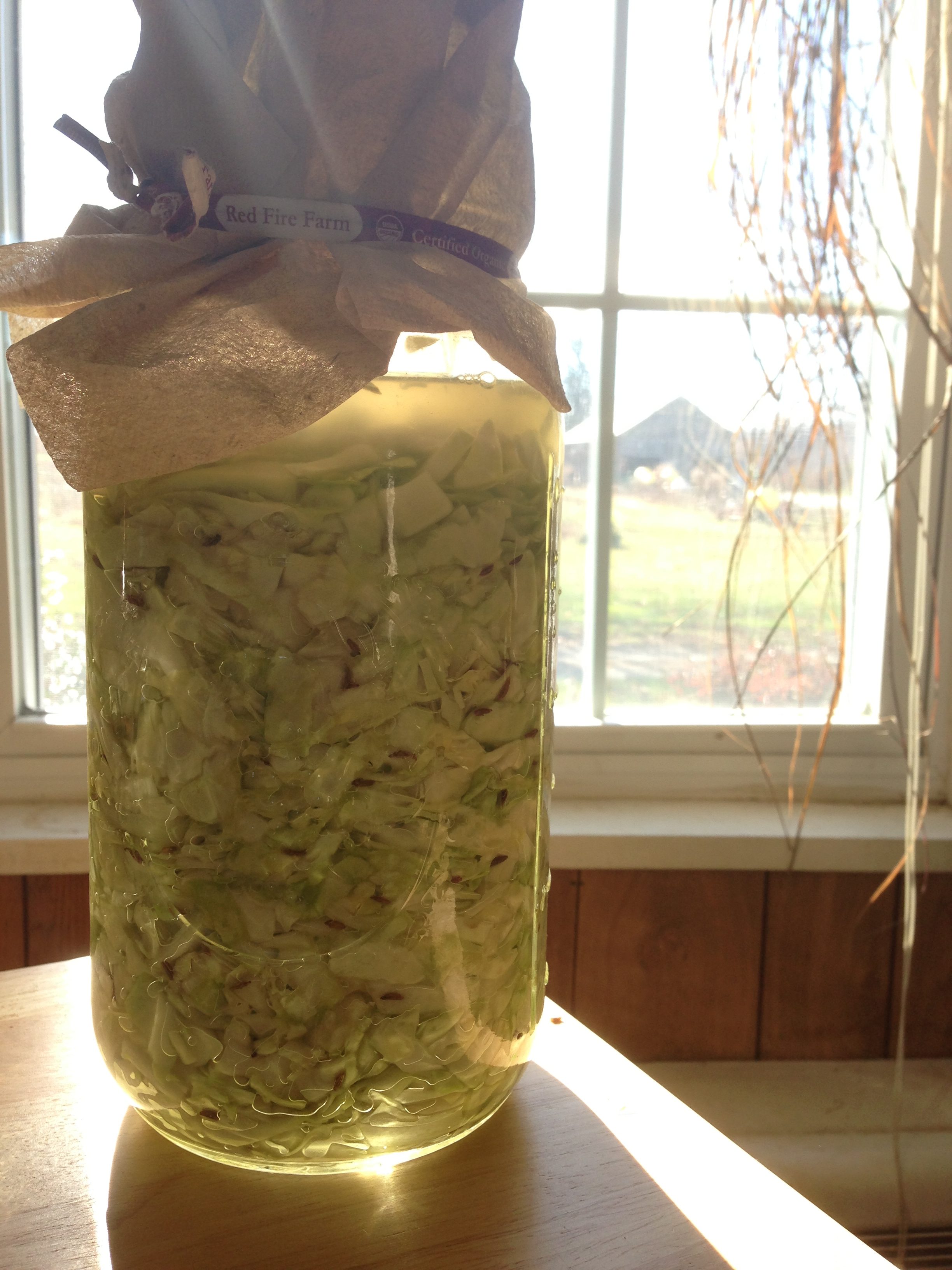
Sauerkraut with caraway seeds. The weight jar is covered by a napkin and the cover is secured below the rim of the large jar in case of dust or bugs. Kinda makeshift.
If you’d like to flavor your sauerkraut…
Lately we are fond of caraway seeds, they add such dimension to the taste of sauerkraut, nuttiness and aromas. Some other fun options… juniper berries, dill seeds, celery seeds, ginger, hot pepper flakes, turmeric, apples, cranberries, sweet white wine, oregano, other vegetables. Go exploring!
Another way to go is to make Kimchi, which tends to be cabbage with a mix of vegetables and includes some hot pepper. Here’s a kimchi recipe from Amy, one of our members.
How to Eat It
This time of year we are starting new batches soon after one finishes, and eating them right quick. You are likely to see me eating sauerkraut or something lacto-fermented at any meal of the day now that we are in the groove. Wally likes to snack on it! I am fond of putting it out with a bit of other snacks like carrots and cheese as a finger food or lunch. Raw is best as you get the probiotics. It tops salads, goes along with any meal on the side, and dresses up sandwiches. Great with breakfast eggs and toast. And on bagels with cream cheese. Basically you can eat it anywhere is what I’m saying here. More versatile than ketchup! And it will save you from scurvy.
Further Reading
If you want to delve deeper into the fascinations of lactofermentation I recommend Sandor Katz’s books, Wild Fermentation and The Art of Fermentation. If you have read any other good ones, please share in the comments!
Here is a larger batch sauerkraut recipe on Sandor Katz’s website.
Water
If you add water at some point to keep your liquid level up, beware of chlorine. Chlorinated water can cause problems for fermentation, as chlorine kills your beneficial bacteria. If you have chlorinated water, you can boil it in an open pot to evaporate the chlorine, then cool it to room temperature (so hot water doesn’t kill desired microbes). You can also let it sit in an open container for a few days, and the chlorine will evaporate. Or you can filter it with charcoal filters.
Containers
Glass jars are a good container as they are non-reactive. I got some larger half gallon Ball jars that fit right into the fridge after fermenting on the counter. You can use quart jars or whatever you have. We also do bigger batches in food-safe plastic buckets.
I read recently in Katz’s book about a woman who uses the old style canning jars with glass lids and rubber seals to ferment – she says that she can close the jar and the gases of fermentation escape through the seal when the pressure builds, but it is sealed, so nothing gets in, and she has no incidence of mold. Sounds worth trying.
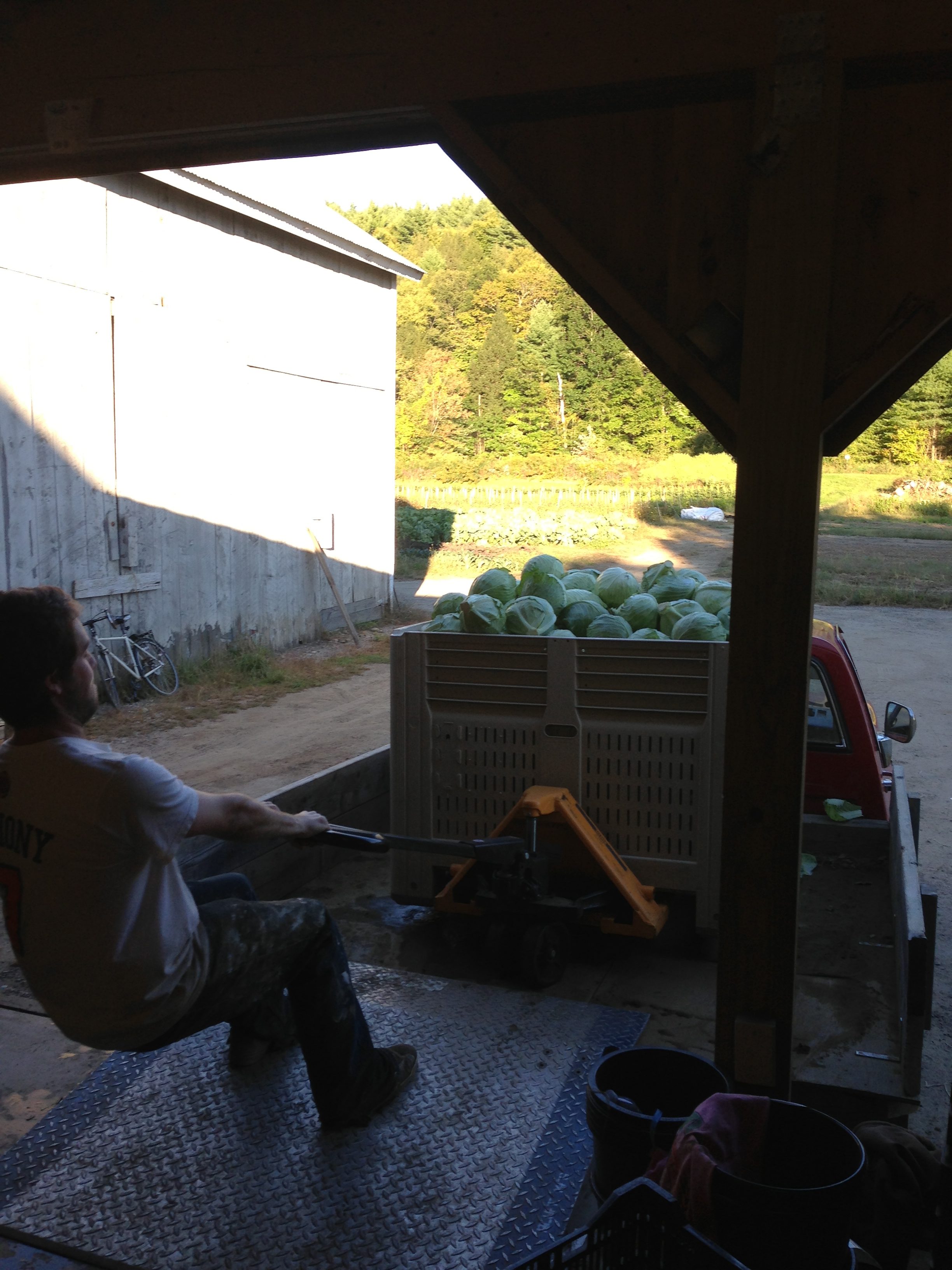
Bringing in the Harvest
There’s Max pulling in a bin of cabbage. After harvest, we bring the bins in and store some in our root cellar for the winter. Storage varieties of cabbage will last months in the right conditions. We have a good amount of it this year! Please take some off our hands and make sauerkraut!
Cheers,
Sarah




